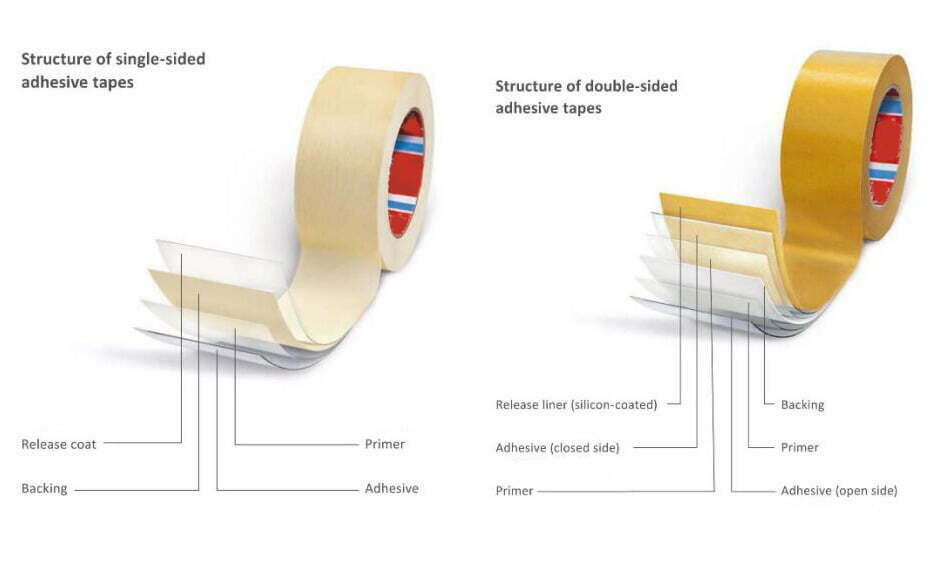I. Definition of adhesive tape
Pressure sensitive tape means that the tape adheres easily to the surface being adhered by touch and light pressure. Pressure sensitive tape is a viscoelastic polymer with both liquid and solid properties. Therefore, compared with glue, adhesive tape does not need to be cured during bonding, which can save man-hours. Tapes are used in a wide range of fields. In addition to daily office tape products, tapes are also used in many industrial fields such as automobiles, electronics, paper printing, construction, home appliances, new energy, and rail transit.

II. The structure of the tape
Adhesive tapes generally consist of coatings with various functions. The adhesive is applied to one or both sides of the substrate (to make single- or double-sided tapes). The following diagrams show typical constructions of single-sided or double-sided tapes.
III. Types of substrates
The task of the substrate is to hold the adhesive and primer. The base material is very rich, from paper to plastic film, etc. Different materials have different characteristics and are suitable for various application scenarios.
Common substrates:
- Film tape (PP, PET,PVC)
Dimensionally stable, chemically stable, temperature resistant (PET), transparent or white
Non-woven tape
Docile, heat-resistant, hand-tearable, transparent - Foam tape (PE)
Vibration and noise reduction, suitable for rough surfaces, compensates for thermal expansion and contraction between different materials (such as glass and metal), black or white - Cloth/fabric tapes are compliant, scratch-resistant, hand-tearable, and have a high amount of glue.
- Asymmetric Tape
Differential adhesives are coated on both sides of the substrate, resulting in different peel forces on both sides. - Non-backing tape
There is no base material, only the adhesive is attached to the release paper, which has excellent conformability and is very thin.
IV. Types of adhesives
The coating weight (g/m2) and formulation of the adhesive depends on the application for which the tape is designed.
Common adhesives are acrylic adhesives, natural rubber adhesives and synthetic rubber adhesives. Different adhesives have different basic characteristics, and acrylic adhesives are generally better suited for permanent and outdoor applications.
Comparative analysis of two main adhesives:
Acrylic Adhesive:
- Advantages
Excellent adhesion to polar materials (PET, PC, glass, metal)
Heat resistant
Aging resistance
Can withstand various environments
Typically higher shear resistance at elevated temperatures - Limitations
Final bond strength is achieved after a rest period, so repositioning is possible
low initial bond strength
Relatively low adhesion to polar materials
Rubber adhesive:
- Advantages
High initial viscosity
Realize fast bonding with the adherend
Excellent adhesion to non-polar surfaces such as PP, PE, or EPDM - Limitations
Relatively low high temperature resistance
Relatively low aging resistance
Relatively low environmental performance
Relatively low chemical resistance
Relatively low moisture resistance
V. Types of release paper/film
The type of material of the release paper determines its physical properties, such as tensile strength, elongation, tear resistance, moisture resistance stability, cutting debris… The release force of the release paper/film should not be too large to cause tape It is difficult to peel off, and it should not be too small to fall off.
Common release paper/film:
- Cellophane
tearable
good tensile strength
Good electrostatic discharge performance
The paper core is relatively hard and has strong compressive stability
die cut
cost-effective - PE coated paper
high dimensional stability
PE coating prevents moisture absorption
tearable
good tensile strength
Good electrostatic discharge performance
die cut - MOPP film
Dimensionally stable, good tensile strength
Moisture-proof
Small thickness tolerance
die cut
translucent - PE film
Good elasticity, suitable for wrapping thicker products
Moisture-proof - PET film
High temperature resistance (up to 150°C)
Small thickness tolerance
dimensionally stable, thin
die cut
transparent
